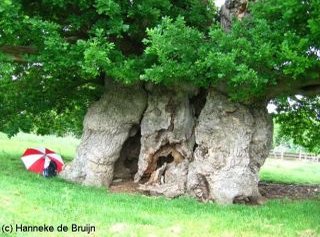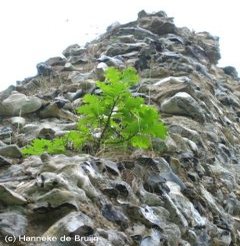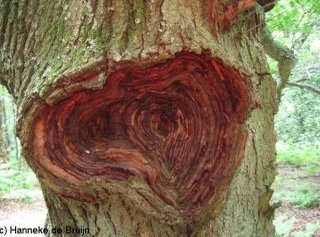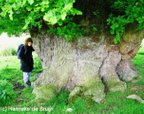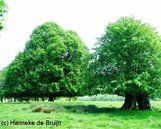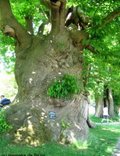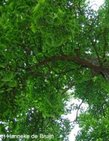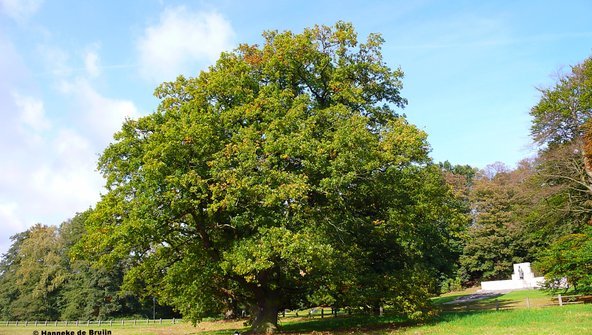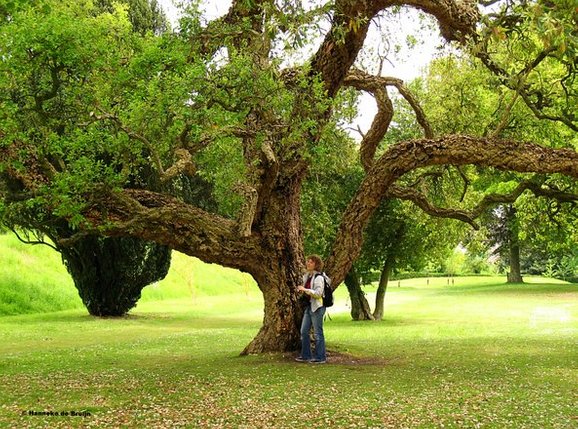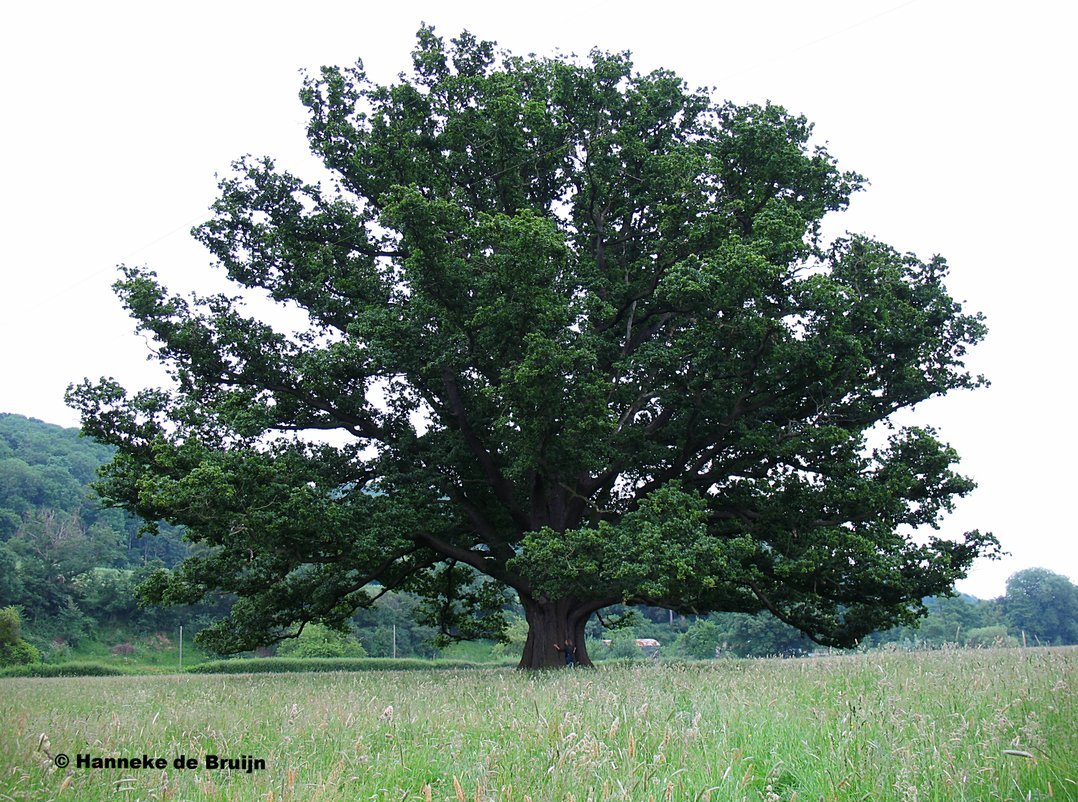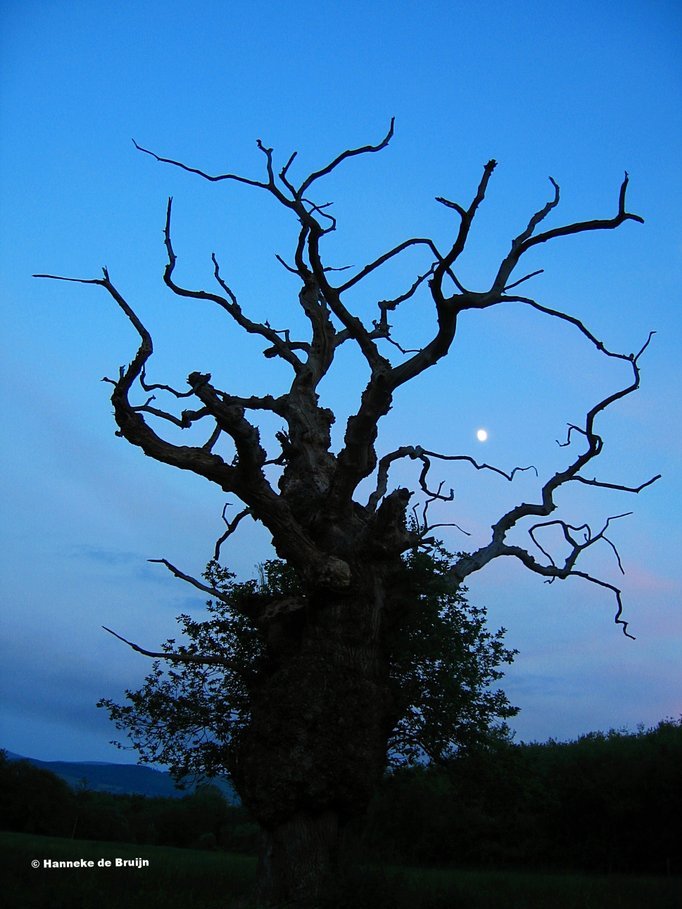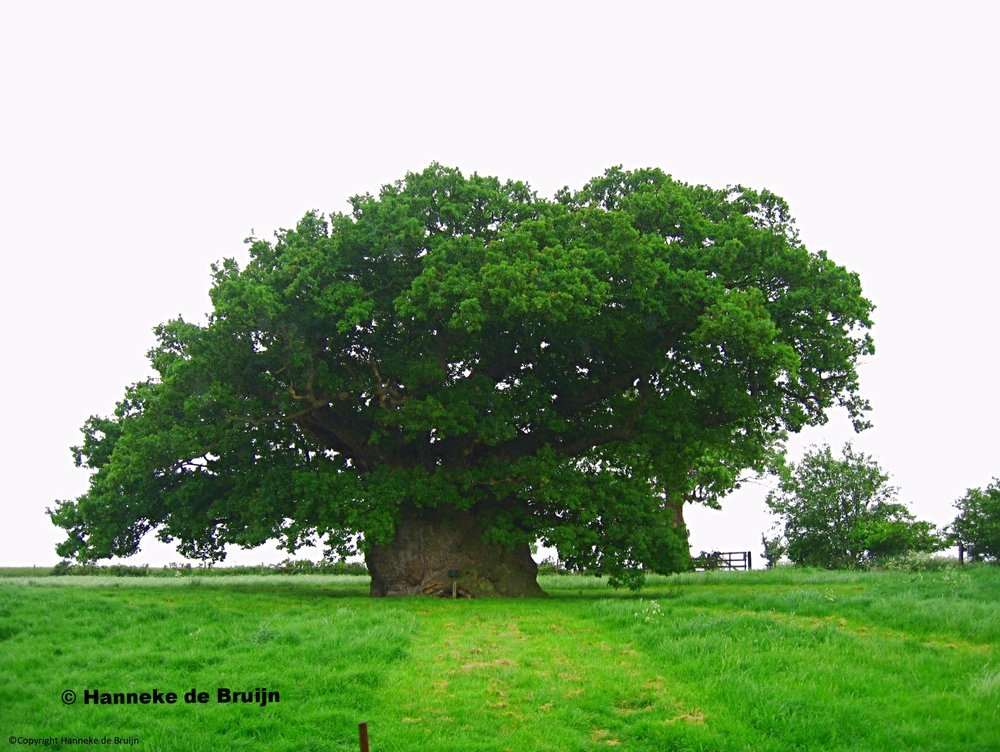My Passion for Trees
© Copyright Hanneke de Bruijn
Tree species on this website:
The Oak.
The oak is a strong and powerfull tree. Since the beginning of time, the oak was a sacred tree. Many judgements were taken and executed under the trees. Oaks are special trees.
The oaks are amazing powerful trees.
English oak or Pedunculate oak (Quercus robur)
Wide spread across Great Britain, Q. robur is a large Tree. Q. roburis monoecious, (what means that female and male the flowers on the same tree occur) deciduous tree 82,02 –114,83 ft (25–35 m) tall (exceptionally to 164,04ft (50 m)), with shallow lobed and nearly sessile (very short-stalked) leaves 2,76 – 5,51 inch (7–14 cm) long and auricled at the base. The unspectacular flowering takes place in mid spring (April till may), flowers of female (spikes) are 0,98 inch (2,5 cm) long and pale green. Their fruit, called acorns, ripen by the following autumn(half august till October). The acorns are 0,79– 0,98 inch (2–2,5 cm) long, pedunculate (having a peduncle or acorn-stalk, 1,18– 2,76 inch (3–7 cm) long) with one to four acorns on each peduncle. The nut is surrounded at the base by a cup-like involucre. The buds are short and blunt, shinny pale brown and generally glabrous, but very variable. The bark of young trees is and smooth and gleaming greenness. Older trees the bark becomes deeply fissured and rather irregular grooved and greyish of colour. Beside length grooves in the bark the tree had horizontal. Very old oaks show frequently very deep grove in the bark. Century old oaks are hollow inside. It is a long-lived tree, with a large widespreading head of rugged branches. The English oak is an pioneer tree, the seedling invade an open grassland rather than dense forest.
The Sessile Oak (Quercus petraea)
Also known as Durmast Oak, is a species of oak native to most of Europe, and into Anatolia. The Sessile Oak is a large monoecious, deciduous tree up to 65,62 - 131,23 ft (20-40 m) tall, similar to the Pedunculate Oak, and the flowers are unisexual. The leaves are 2,76-5,51 inch(7-14 cm) long and 1,57 -3,15 inch (4-8 cm) broad, evenly lobed with five to six lobes on each side, and a 0,39 inch (1 cm) petiole. And symmetrically. Not rounded by the base. The leafstalk at the Sessile oak are generally much longer: 0,3937-1,1417 inch (10-29 mm) long against 0,0787-0,3150 inch (2-8 mm) at the Pedunculate oak. Leaves are generally gleaming dark green of colour and mullet. Also the cups and the acorns of the Pedunculate oak stands on stalk and those of the Sessile oak have none or very short stalk. The name “sessile” refers to the way the acorn cup sit right on the twig. The flowers are catkins, produced in the spring. The fruit is an acorn 0,79 -1,18 inch (2-3 cm) long and 0,39-0,79 inch (1-2 cm) broad, which matures in about 6 months. Also the branch generally less is twisting and angular. The crown makes closer and more regular impression. The oak belongs to cup bearer family (Fagaceae). This name has been given, because the lower part of the acorns sits in a cup.
Source: Wikipedia and guids
Here you can read the stories about the trees.
Quercus
Sonsbeek oak, Arnhem, NL.
GPS: 51°59'21.29"N, 5°54'10.28"O
Cork oak, Arundel, UK.
GPS: 50°51'15.62"N, 0°33'8.01"W
Fownhope, Hereford, Herefordshire, UK.
(GPS camping 52°1'23.18"N, 2°37'49.74"W)
The story of this tree.
Onthe corner of the campsite was a public footpath into the field beyond. Curious what lies beyond the corner, we follow the path after dinner. The path follows the river for a while, but not long enough. It goes into the field. The further we came, the older trees gets. Like Old hawthorn hedges. You could see how they were made. Planted more than 100 years ago and bend downwards to form a hedge. Old hollow ash trees, old willow trees with a yew in his crown... As we goes on, the trees gets more beautiful with every step. On a distance we could see a huge tree, not know what kind and we diverted from the footpath an walk to the tree. The closer you came the more awe I had for the tree. When I was close to the tree, I realised something. When I was a young girl, I had my bedroomwall decorated with pictures, paintings and sketches of trees and the like. One of the sketch that was hanging on my wall back then, was this tree!! Exactly the same!! How amazing! This tree stand very remote but very powerful and strong. I walk into the high grass field towards the tree, to examine it better. I walk around it to make pictures of him. When I was at the back of the tree, I heard a lot of noise. The farmer stood their screaming that I had to go off his land. His behaviour was like I was an kind of animal. I slowly retreat. Sad to leaving the tree like this. But understandable, It was privet land afterall.
GPS Tree: 52°0'51.90"N, 2°37'38.76"W.
Llangadog, Dyfed, Wales, UK.
The story of this tree
In a search for a camping (GPS camping: 51°56'58.86"N, 3°53'57.13"W) in Wales we came at a place full of history. We camped next to a small stream with kingfishers and old trees. After dinner we stroll around the woods on a slope on the other side of the stream. Nice wood. On the top of the slope there is an open space with trees and horses. We take a close look what kind of trees they were. Oak trees. The closer we came the more we realise that the trees were older that you expect. The left one was in good condition, good in leaf and a good size trunk. The right one had a good size trunk and was in a half state. Half in leaf and half barren and dead branches and with other plants in it. It was already the twilight zone and it was a bit spooky sight. The barren branches with the full moon shining through it... Goosebumps everywhere... I want to run away. 2 amazing trees. We ask the next day to the owner of the camping if he knew the trees and their age. He didn´’t. But he could tell us that the Romans lived here. Aha..!! The trees are from the Roman time and a few people hanged in the right tree.. That´s why we have Goosebumps!. A half a mile in the forest were the remnants of a wall of the Roman villa. The space was already occupied by an owner who build his house in-between the wall.
GPS boom: 51°56'59.41"N, 3°54'3.88"W.
Bowthorpe oak, Bourne, Lincolnshire, UK.
Story of this tree:
In a book (Meetings with remarkable trees by Thomas Pakenham) I had read about this tree that it might be the oldest and biggest Oak of Great Britain. We were curious and visit the tree. The tree grows on a privet ground on a farm land. You need to have the address of the tree to find him (Bowthorpe park farm, on the A6121 from Stamford towards Bourne, Manthorpe, Bourne, Linconshire. GPS 52°43'32.39"N, 0°25'46.15"W). The owners of the farm (and the tree) want you to pay a small fee. Which I found a bit strange since everything in nature is free... To get to the tree you need to pass though a barn and farm land with chicken running free. The tree is only visible beyond the barn. Not a high tree but one with a big belly. The tree is huge and very old. And... in good condition. Impressive. More than 32,81 feet (10 meter) in girth. He was 98,43 feet (30 meter) in high, but not anymore since the top is blow over. He now is 65,62 feet(20 meter) more or less. The oak is hollow inside and there was (in the early days) enough space for a table and benches. Since the top was blown over the owner put iron chains on the trunk and some of his branches to secure the tree. We have seen many old oaks, but not as big, old and beautiful as this one. Probably the oldest and biggest of England indeed. (If you didn’t count other never seen ancient oaks on privet land). When we visit this tree it was a bit raining and windy but that could not hold us back to enjoy the tree and the chicken around it. The tree is al least 800 years old, probably older. Worth every penny.
mypassionfortrees.nl ©Hanneke de Bruijn. 2008 - 2020. • Privacy Policy • Terms of use.
